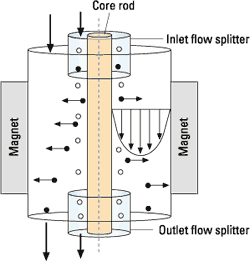Magnetic Activated cell sorting is a technique that uses small paramagnetic iron-oxide particles to separate cells or nucleotides from solution. These particles are often called magnetic nanoparticles due to their small sizes ranging from less than 100 nm to 5 μm. The technique requires and external magnet to create a magnetic field gradient. The magnetic particles are chemically altered to be biologically compatible and to specifically bind to a variety of different cell types. The cells of interest can be bound by the particles and isolated from solution (positive selection) or the unwanted cells can be bound and removed from solution (negative selection).
Magnetic Particle Composition
The magnetic nanoparticles used for magnetic activated cell sorting are made of an iron-oxide core with a thin polymer coating. The polymer coating can vary, but common materials used are citrate, polyacrylate, and silica. The coating must have functional groups that can bind to the iron-oxide core. The coating can make the beads hydrophilic, hydrophobic, or biologically inert.
The most exciting part of the magnetic particle is the functional moiety that is attached to the polymer coating. These moieties range from specific antibodies to enzymes or nucleotides. There is a wide market for antibody-bound beads as these can be adapted for a wide variety of cell types.
The separation process
Iron oxide at the nanometer scale is paramagnetic, which means that it has no magnetism by itself. However, it can become magnetic when placed in close proximity to a permanent magnet. The permanent magnet influences the magnetic dipoles of the iron oxide particles, which causes the particles to rotate (due to torque from a constant magnetic field) or change location (in a magnetic field gradient). When an external permanent magnet creates a magnetic field gradient the magnetic particles become magnetized and aggregate together to move through the gradient toward the magnet.
Smaller magnetic particles require a stronger magnet to reach saturation and to separate out of solution, but the smaller size allows multiple beads to bind to each cell. Both the large and small beads can be removed from the isolated cell population if necessary. Many commercial companies make beads of various sizes, homogeneity, coatings, functional moieties, and removability.
While the operator can often visualize when separation is complete by watching the solution change from cloudy to clear, software such as the Sepmag quality control recording (QCR) system can automatically track the progress of the sort and provide quantitative feedback as well as diagnose problems with the sort as early as possible.
Magnetic Activated cell sorting has many advantages over traditional column-based methods due to increased specificity, decreased procedure time, and increased cell viability. Advances in the technology are continuing at a rapid pace as new technologies combine magnetic particles with fluorescent tags, and as the specificity of the particles improvesand expands to include new population of cells, nucleotides, and pathogens to be identified and isolated.
Related news:
- Reversible aggregation of magnetic particles using a temperature-responsive polymer
- From the Inside Out: Investigating the Layers of a Magnetic Nanoparticle
- Magnetic-Particle-Based Chemiluminescent Immunoassay





